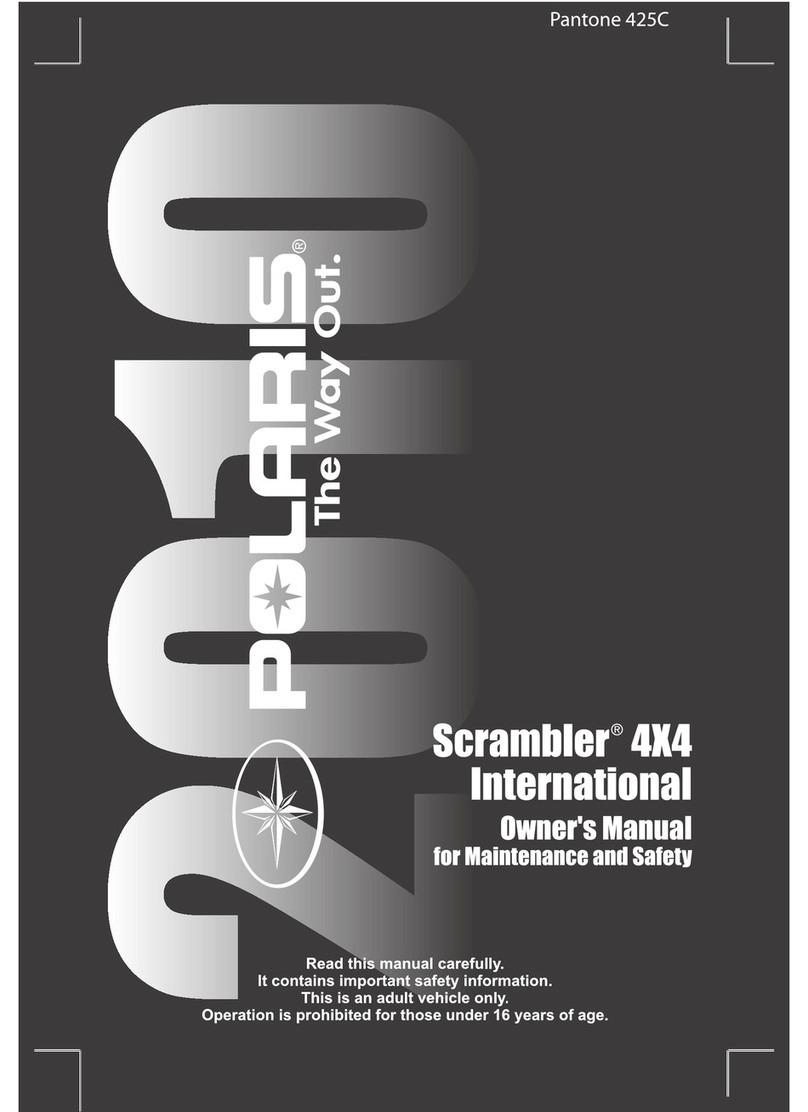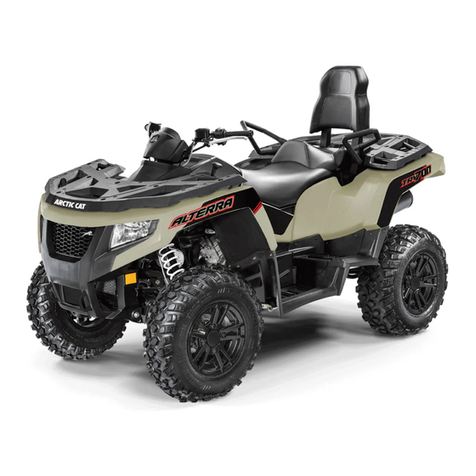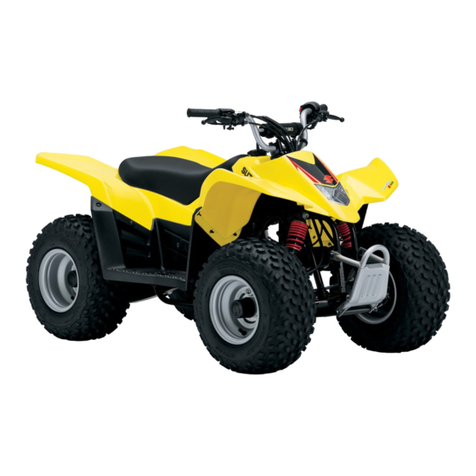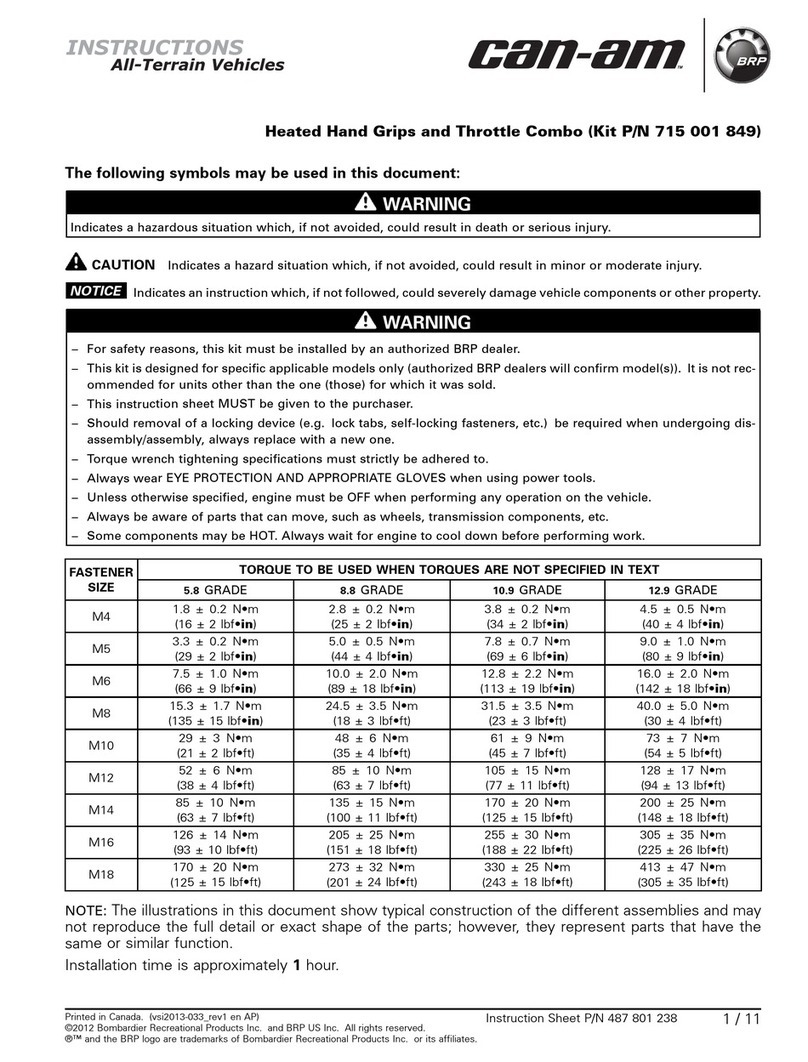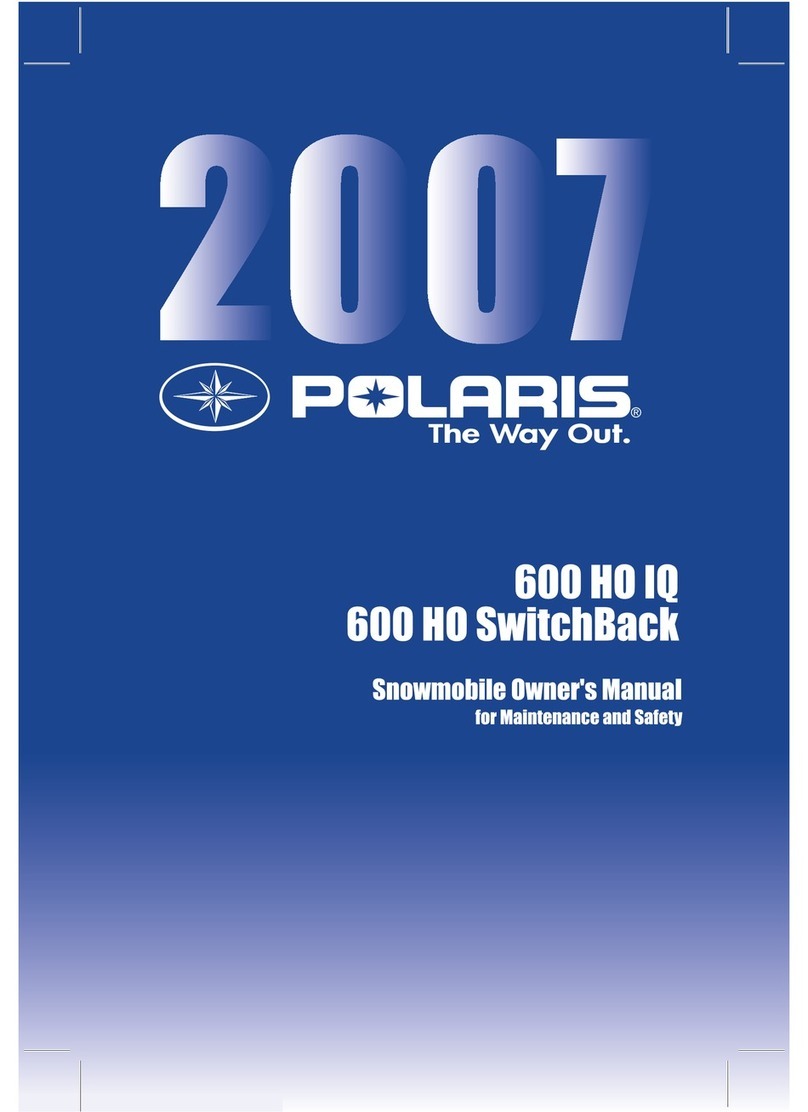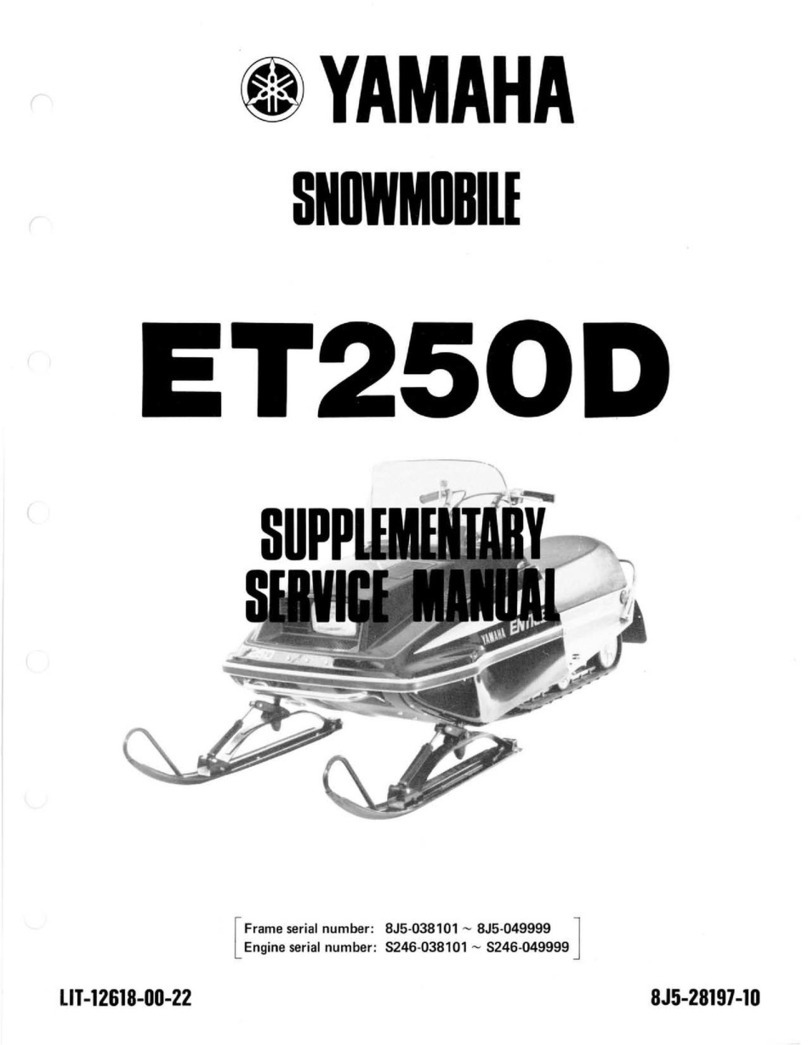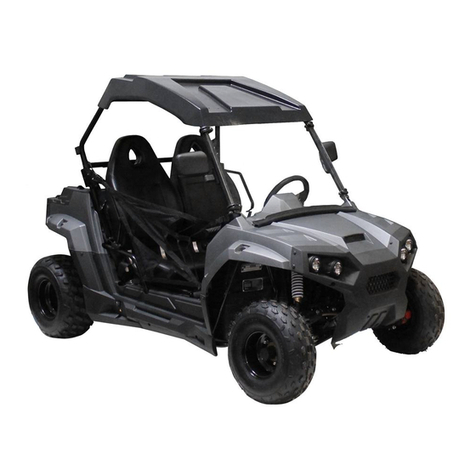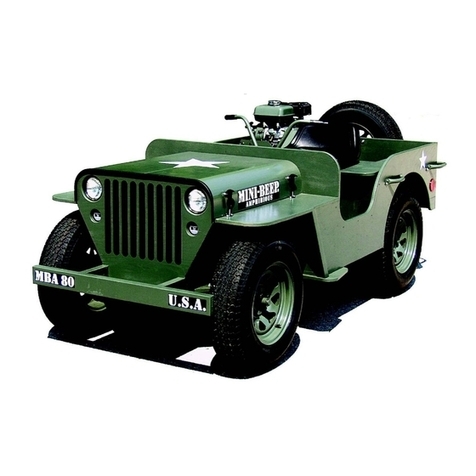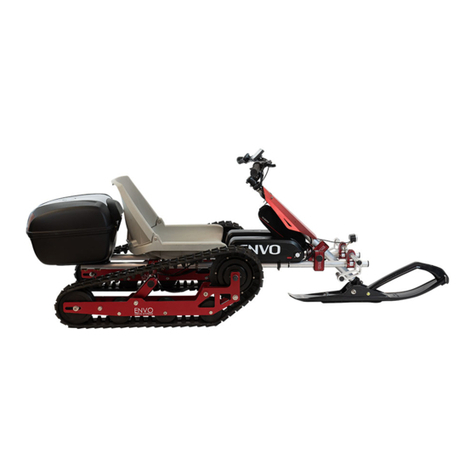Evinrude Bobcat E251C User manual

25
HORSEPOWER · MODELS E251C E251M
32
HORSEPOWER · MODEL E251 HP
743
10-70
PART
NO_
261888
LlTHO
U.S.A.
©
OUTBOARD
MARINE
CORPORATION
1970
ALL
RIGHTS
RESERVE:D

AVAILABLE
FROM
YOUR
EVINRUDE
DEALER
FUEL
RECOMMENDATIONS
The
correct
fuel
mixture
ratio
is
24
parts
of
a good
grade
gasoline
to
one
part
oil.
Use
regular
gasoline
in
Model 251
and
premium
gasoline
in
the
251
HP.
For
ease
of
measurement,
this
is
equivalent
to
one
quart
of
oil
to
six
gallons
of
gasoline,
one
pint
of
oil
to
three
gallons
of
gasoline,
or
1/ 3
pint
of
oil
to
each
gallon
of
gasoline.
Use
only
Evinrude
Lubricant
or
a
reputable
auto
motive
engine
oil,
SAE 30
MS
or
MM. Avoid
use
of low
price
third
grade
(ML
light
duty)
oils.
DO
NOT USE
MULTIPLE
VISCOSITY OILS, SUCH
AS
10W30,
OR
ANY OUTBOARD MOTOR OILS
OTHER
THAN EVINRUDE OUTBOARD
LUBRICANT.*
*EVEN THOUGH EVINRUDE OUTBOARD LUBRICANT
IS
ADVER-
TISED
AS
A 50:1 RATIO LUBRICANT, IT
IS
IMPERATIVE
FOR
SNOWMOBILE USE THAT
IT
BE
MIXED AT A 24:1 GAS-
LUBRICANT RATIO.
DO NOT
POUR
GASOLINE
OR
LUBRICANT
DIRECTLY
INTO
VEHICLE
FUEL
TANK. USE
AN
APPROPRIATE
CONTAINER
FOR
MIXING
AND
STORING THE
FUEL.
To
prepare
the
snowmobile
fuel
properly,
pour
into
aSEPARATE,
clean
container
half
the
amount
of
gasoline
required
and add
all
the
required
lubricant.
Thoroughly
shake
this
partial
mixture.
Next,
add
the
balance
of
gaso-
line
necessary
to
bring
the
mixture
to
the
required
ratio
of
24:1.
Again,
thoroughly
agitate
the
mixture.
A
clean
funnel
equipped
with
a
fine
screen
should
be
used
when
pouring
the
fuel
mixture
into
the
vehicle
tanle
24
to
1
lubricant
is
prediluted
to
provide
excellent
mixability
with
gaso-
line
at
low
temperatures.
The
addition
of
this
dilutent
does
not
in
any
way
affect
the
lubrication
qualities
of
the
lubricant.
Whenever
it
is
necessary
to
mix
fuel
and
lubricant
at
temperatures
below
O°F,
the
lubricant
should
be
prediluted
with
gasoline
to
improve
its
mixability.
The
lubricant
should
be
prediluted
with
approximately
one
part
gasoline
to
one
part
lubricant.
Predilution
of
the
lubricant
should
take
place
with
the
lubricant
temperature
above
0
°F.
Do
not
use
kerosene
or
fuel
oils
for
pre-mixing.

c
c
SECTION
1
INTRODUCTION
INTROOUCTION
SPECIFICATIONS
GENERAL
SNOWMOBILE
INFORMATION
TROUBLE
SHOOTING
TUNE-UP
PROCEOURES
FUEL
SYSTEM
IGNiTrON
AND
ELECTRICAL
SYSTEM
MANUAL
STARTER
ENGINE
~
__
O_R_IV_E_T_R_A_IN
__________________
~
STEERING,
TRACK
ANO
SUSPENSION
LUBRICATION
ANO
STORAGE

1-2
17000
Figure
1-1
The snow
machine
has
been
designed
and
built
for
dependable,
high )
performance.
It
is
important
to
every
snow
machine
owner
to
be
able
to
receive
skilled
and
thorough
service
for
his
vehicle
when
necessary.
It
is
important
to
the
service
dealer
to be
able
to
offer
the
type
of
skilled
service
which will
maintain
the
customer's
satisfaction.
This
manual,
together
with
the
regularly
issued
service
bulletins
and
Parts
Catalogs,
provide
the
serviceman
with
all
the
literature
necessary
to
service
the
1971
model
251 and 251HP
snowmobiles.
Pictured
be-
low
left
is
the
model
251
and
to
the
right,
the
high
performance,
251HP.
An
effort
has
been
made
to
produce
a
manual
that
will
not
only
serve
as
a
ready
reference
book
for
the
experienced
service
man,
but
will
also
provide
more
basic
information
for
the
guidance
of
the
less
ex
-
perienced
man.
The
Parts
Catalogs
contain
complete
listings
of
the
parts
required
for
replacement.
In addition,
the
exploded
views
illustrate
the
correct
sequence
of
all
parts.
This
catalog
can
be
of
considerable
help
as
a
.
reference
during
disassembly
and
reassembly.
The
Section
Index on
page
1-1
enables
the
reader
to
locate
quickly
any
desired
section.
At
the
beginning
of
each
Section
is
a
Table
of
Contents
which
gives
the
page
number
on
which
each
topic
begins.
This
arrange-
ment
simplifies
locating
the
desired
information
within
this
manual.
Section
2
lists
complete
specifications
on
the
1971
snowmobiles.
All
general
information,
including
2
cycle
engine
theory,
trouble
shooting,
and
tune up
procedures,
are
given
in
Sections
3
through
5 of
this
manual.
17022
Figure
1-2
-

c
(
Sections
6
through
11
provide
fully
illustrated,
detailed,
step-by-step
disassembly
and
reassembly
instructions
and
adjustment
procedures.
Section
12
provides
lubrication
and
storage
information.
In
this
way,
the
texts
treat
each
topic
separately;
theory
and
practice
are
not
inter
mixed.
This
makes
it
unnecessary
for
the
experienced
service-
man
to
reread
discussions
of
theory
along
with
specific
service
in-
formation.
illustrations
placed
in
the
margins
provide
unimpeded
reading
of
explanatory
text,
and
permit
close
relationship
between
illustration
and text.
Read
this
manual
carefully
to
become
thoroughly
familiar
with
the
procedures
described,
then
keep
it
readily
available
in
the
service
shop
for
use
as
a
reference.
If
properly
used,
it
will
enable
the
serviceman
to give
better
service
to
the
snow
machine
owner,
and
thereby
build
or
maintain
areputation
for
reliable
service.
This
service
manual
covers
all
phases
of
servlcmg
the
1971
snow-
mobiles,
without
reference
to
other
information;
however,
new
service
situations
sometimes
arise.
If
a
service
question
does
not
appear
to
be
answered
in
this
manual,
you
are
invited
to
write
to
the
Service
Depart-
ment
for
additional
help.
Always
be
sure
to
give
complete
information,
including
model
number
and
vehicle
se
rial
number.
All
information,
illustrations,
and
specifications
contained
in
this
literature
are
based
on
the
product
information
available
at
the
time
of
publication.
The
right
is
reserved
to
make
changes
at
any
time
without
notice.
17002
1. Hood
Latch
(Wing Nut)
6.
Hand
Brake
with
2.
Neutral
Lockout
Knob
Parking
Lock
3.
Headlight
Connector
7.
Throttle
Lever
4.
Ignition/Lights
Switch 8.
Primer
5.
Compression
Relief
9.
Manual
Start
Handle
Figure
1-3
1-3
-

).
)
---
~-
---
.......

c
SECTION
2
SPECIFICATIONS
TABLE
OF
CONTENTS
SPECIFICATIONS
............•.•...
2- 2
TORQUE
SPECIFICATIONS
. . . . . . . • . . . .
2-3
2-1

2-2
For
your
own
protection,
before
proceeding
with any
repair
or
adjustments
on
these
snowmo-
biles,
see
on
pages
4-7,6-6,7-7,
8-2,
9-2,
9-6
and
11-4.
SPECIFICATIONS
CAUTION: Snowmobiles
are
not
manufactured
for
highway
use
and
the
manufacturer
does
not
represent
that
they
are
equipped
with
all
the
de-
vices
legally
required
for
such
use.
Length Model
251
...........................
96
inches
Model
251
HP
. . . . . . . . . . . . . . . . . . . . .
..
98
inches
Width
...........................
32-9
/16
inches
Height Model
251
...........................
42
inches
Engine
Rating
Model
251
HP
. . . . . . . . . . . . . . . . . . . .
..
37-1/2
inches
. . . . . . . . . . . . . . . . . . OMC
2-cycle
opposed
twin
Model
251
..............
Maximum
25
HP
at
5300
RPM
Model
251
HP
..........
. .
Maximum
32
HP
at
6200
RPM
Starter
................................
Manual,
rewind
Clutch
...............
Centrifugal
operated
sheave
engages
belt
Drive
.....................
Variable-speed,
V-belt
and
chain
Drive
Sprocket
Ratio
(Standard) . . . . . . . . . . . . . . . . . . .
..
16
to
30
Options
..
. . . . . . . . . . . . . . . . .
..
11, 13, 15
or
18
to
30
Transmission
.........
Variable
speed,
3:1 to 1:1
ratio
Forward
only
Mufflers
Model
251
...
Single
Tuned
engine
muffler
for
quiet
operation
Model
251
HP
..
Dual
Tuned engine
mufflers
for
maximum
Brake
.
Throttle
....
Track
....
.
Width:
..
.
Skis
.....
.
performance
· . . . . . . .
.......
Disc
type,
hand
operated
· . . . . . . . . . . . . . . . . . . . . . . . .
thumb
operated
· . . . . . . . . .
Specially
designed
fully
adjustable
· . . . . . . . . . . . . . . . . . . . . . . . .
..
15-3/8
inches
. . . . . .
Formed
steel,
equipped with
shock-absorbing
Seating
capacity
...
leaf
springs
and
replaceable
wear
runners
..
....
Two
adults.
Vinyl
coated
twill
cover,
molded
urethane
foam
cushion
Hood
.................
Molded
fiberglass
with
built-in
headlights
Lighting
........................
2
Headlights,
and
taillight
Fuel
tank
. . . . . . . . . . . . . . . . . . . . . . . . .
..
6 U.S.
gallons
Fuel
Model
251
.....................
good
grade
regular
Model 251
HP
. . . . . . . . . . . . . . . . . . good
grade
premium
Lubrication.
. . . . . . . . . . . . . 24:1
using
Evinrude
24
to 1
lubricant
or
SAE 30
MM
or
MS
oil
Carburetor
Needle
Adjustment
High
speed
........
.
Low
speed
..............
.
RPM
Ratings
. . . . .
..
1
turn
off
seat
1
to
1-1/4
turns
off
seat
Idle
...................................
. 1100 -1300
2300 -2400
2600 -2800
Transmission
Belt
Engaging Speed Model 251
.......
.
Model 251
HP
Ignition
Breaker
point
gap.
. . . . . . . . . . . . . . . . . . . . . . .
..
.022 to .024
Spark
plug Model 251
...........
Champion
J7J
or
equivalent
Model 251
HP
........
Champion
J4J
or
equivalent
Spark
plug
gap.
. . . . . . . . . . . . . . . . . . . . . . .
..
.028 -.032
inch
Condenser
capacity
...................
.18 -.22
mfd
Magneto
driv~
coil
resistance.
. . . . . . . . . . . . . . . . .
..
.8
ohm
Ignition
coil
primary
resistance
......
. . . . . . . . . . .
..
1. 5
ohm
Ignition
coil
secondary
resistance
. . . . . . . . . . .
..
10,000
ohms
Lighting Coil
resistance
....
.678 to .562
ohm
Engine
Bore
and
stroke
......
'. . . .
2-3/4
x
2-1/4
inches
Piston
displacement
. . . . . . . . . . . .
..
437
cc
or
26.7
cubic
inches
Compression
ratio
Model 251
.....................
7
to
1
Ring
diameter
....
Ring
thickness
. . . .
Cylinder
Compression
Model 251
HP
. . . .
.........
8
to
1
. . . . . . . . . . . . . . . . .
..
2-3/4
inches
. . . . . . . . . . . . . . . . . . .
..
1/16
inch
Model 251
.........................
.
minimum
105
PSI
minimum
120
PSI
Model 251
HP
..................
.
Clearances
Piston
-
wrist
pin
. . . . . . . . . . . . . . . . . .
.......
Press
fit
Piston
ring
gap.
. . . . . . . . . . . . . . . . . .
.007
-
.017
Piston
ring
-
ring
groove
. . . . . . . . . . . .
.002
-.004
Cylinder
-
piston
...........
Top of
piston
to
cylinder
.012 -.014
Bottom
of
piston
to
cylinder
.006 -.010
Specifications
and
features
may
be
changed
at
any
time
without
notice
and without
obligation
towards
vehicles
previously
manufactured.
---)
)

c
TORQUE
SPECIFICATIONS
PART
APPLICATION
SIZE TORQUE
IN./
FT.
/
LBS. LBS.
Screw
Brake
Hand
Lever
#10-32
13-15
Screw
Coil
Clamp
to
Main
Frame
35-45
*
Screw
Connecting
Rod 29-31
*
Screw
Crankcase
60-80
6-7
* Nut
Cylinder
Base
16-20
*
Screw
Engine
to
Engine
Frame
Assembly
33-38
* Nut
Flywheel
40-45
* Nut
Engine
Frame
to
Main
Frame
3/
8-16
18-20
* Nut
Front
and
Rear
Truck
Axles
5/
8-18
50-60
*
Screw
Idler
Axle
to
Frame
5/8-18
20-25
Bolt
and
Nut
Rear
Axle
Pivot
12-15
Setscrew
Rear
Sprocket
18-20
Nut
Rear
Suspension
to
Frame
12-15
* Nut
Runner
to
Ski
90-100
* Nut
Saddle
to
Spring
3/8-24
25-30
Spark
Plug
20-20-1
/ 2
Nut
Throttle
Control
Cable
30-40
* Nut
Tie
Rod
3/
8-24
18-20
*
Screw
Truck
to
Frame
(Cleated
Track
Models)
3/
8-16
25-30
*
Screw
Truck
to
Frame
(Molded
Track
Models)
7/16
25-30
* Nut
Steering
Arm
to
Ski
Column
3/
8-24
18-20
*
Bolt
(Early
Primary
Bolt
to
End
Cap
70-80
MOdels)
*
Bolt
(Later
Primary
Bolt
to
End
Cap
90-100
MOdels) (Has
annular
groove
in
Screw
head).
See
Figure
2-1
#6
7-10
Screw
#8
15-22
Screw
#10
25-35
2-3
Screw
#12
35-40
3-4
Screw
1/4
60-80
5-7
Screw
5/16
120-140
10-12
Screw
3/8
220-240
18-20
Specifications
and
features
may
be
changed
at
any
time
without
notice
and
without
obligation
towards
vehicles
previously
manufactured.
*Use
Torque
Wrench
2- 3
ANNULAR
GROOVE
1
7192
Figure
2-1

)
~--------------------~---------

(
SECTION
3
GENERAL
SNOWMOBILE
INFORMATION
TABLE
OF
CONTENTS
TWO-CYCLE
ENGINE
THEORY
. . . . . . . . . . 3- 2
CARBURETION.
. . . . . . . . . . . . . . . . . .
••
3-3
IGNITION . . . . . . . • . . . • . . . . . • . . . . .
•.
3-3
POWER
FLOW.
. . . . . . . . . . . • . . . . . . .
..
3-4
3-1

3-2
POWER
STROKE
-
DOWN
COMBUSTION
OF
FUEL-AIR
AXIS
OF
ROTATION
Figure
3-1
17133
FUEL
INTAKE
+
EXHAUST
LEAF
VALVES
CLOSED
EXHAUST
PORT
OPEN
Figure
3-2
17134
COMPRESSION
STROKE
-
UP
LEAF
VALVE
FUEL
FROM
PORT
CLOSED
17135
Figure
3-3
TWO
CVCLE
ENGINE
THEORV
An
interna!
combustion
engine
is
one
in
which
fuel
is
burned
inside
the
engine:
acharge
of
fuel
is
introduced
into a
combustion
chamber
(cyl-
inder)
within
the
engine
and
ignited.
The
energy
released
by
the
expan
-
sion
of
the
burning
fuel
is
converted
to
torque
by
the
piston,
connecting
rod,
and
crankshaft.
Internal
combustion
engines
are
classified
as
either
four-cycle
or
two-cycle
engines.
The
"four"
and
the
"two"
refers
to
the
number
of
piston
strokes
required
to
complete
apower
cycle
of
intake,
compres-
sion,
power,
and
exhaust.
A
piston
stroke
is
piston
travel
in
one
direc-
tion
only; up
is
one
stroke,
down
is
another.
In a
four-cycle
engine,
two
crankshaft
revolutions,
or
four
strokes,
are
required
for
each
power
cycle.
In a
two-cycle
engine only one
crankshaft
revolution
is
required
per
power
cycle.
In
a
two-cycle
engine,
the
ignition
of
the
fuel-air
mixture
occurs
as
the
piston
reaches
the
top
of
each
stroke.
The
expansion
of
gases
drives
the
piston
downward
(see
Figure
3-1).
Toward
the
end
of
the
downward
stroke,
ports
which
lead
from
the
cylinder
to
the
exhaust
system
are
uncovered.
The
expanding
exhaust
gases
flow
into
these
ports,
re-
ducing
pressure
in
the
cylinder.
Immediately
after,
intake
ports
are
opened.
These
ports
connect
the
cylinder
with
the
crankcase
where
a
mixture
of
fuel
and
air
has
been
developed
by
carburetion.
The
down-
ward
motion
of
the
piston
compresses
this
mixture
and
forces
it
through
the
intake
ports
into
the
cylinder.
(See
Figure
3-2.)
The
inrushing
charge
of
the
fuel-air
mixture
helps
to
eject
(scavenge)
the
last
of
the
exhaust
gases
from
the
cylinder.
At
this
point,
the
momentum
of
the
flywheel
is
required
to
return
the
piston
to
the
top
of
the
cylinder.
As
the
piston
begins
its
up-
stroke,
it
closes
the
intake
and
exhaust
ports
and
begins
to
compress
the
fuel-air
mixture
trapped
in
the
cylinder
(see
Figure
3-3).
The
upward
motion
of
the
piston
also
reduces
the
pressure
inthe
crankcase.
The
resulting
crankcase
suction
opens
leaf
valves
which
admit
a
fresh
charge
of
air
and
fuel
from
the
carburetor
into
the
crankcase,
thus
preparing
for
the
next
power
cycle.
Near
the
top
of
the
piston
stroke,
the
compressed
fuel-air
mixture
is
ignited,
the
piston
is
driven
downward,
and
the
power
cycle
is
repeated.
At
full
throttle,
this
cycle
may
be
repeated
more
than
five
thousand
times
every
minute.
)

CARBURETION
The
system
which
controls
the
intake
of
the
fuel-air
mixture
in
the
two
cycle
engine
consists
of
a
set
of
leaf
valves
which
serve
the
same
purpose
as
the
intake
valves
on a
four
cycle
engine.
The
leaf
valves
are
thin
,
flexible
metal
strips
mounted
between
the
carburetor
intake
manifold
and
crankcase.
When
the
piston
is
on
the
up-stroke
,
it
creates
a
partial
vacuum
in
the
crankcase.
Atmospheric
pressure
forces
the
leaves
away
from
the
body
(see
Figure
3-
4),
opening
the
passage
between
the
carburetor
and
crankcase.
When
the
piston
is
on
the
down-
stroke,
it
compresses
the
crankcase
charge,
forcing
the
leaves
against
the
passage
opening,
and
sealing
off
the
crankcase
from
the
carburetor.
Since
the
opening
and
closing
may
occur
in
excess
of five
thousand
times
per
minute,
the
leaves
must
be
thin
and
flexible. In
the
snow
machine
engine,
the
leaves
do
not
have
to
seat
exactly
flush
with
the
body
to
permit
normal
operation.
Gasoline,
in
its
liquid
state,
burns
relatively
slowly with
an
even
flame.
However, when
gasoline
is
combined
with
air
to
form
a
vapor
,
the
mixture
becomes
highly
inflammable
and
burns
with
an
explosive
effect.
To
obtain
best
results,
the
fuel
and
air
must
be
correctly
pro
-
portioned
and
thoroughly
mixed.
It
is
the
function of the
carburetor
to
accomplish
this.
Gasoline
vapor
will
burn
when
mixed
with
air
in
a
proportion
from
12:1
to
18:1 by weight.
Mixtures
of
different
proportions
are
required
for
different
purposes.
Idling
requires
a
relatively
rich
mixture;
a
leaner
mixture
is
desirable
for
maximum
economy
under
normal
load
conditions;
avoid
lean
mixtures
for
high
speed
operation.
The
carbure
-
tor
is
designed
to
deliver
the
correct
proportion
of fuel and
air
to
the
engine
for
these
various
conditions.
The
carburetor
is
essentially
a
simple
mete
ring
device.
Needle
valves
permit
a
precise
amount
of fuel to flow
to
the
carburetor
throat.
The
upstroke
of
the
piston
creates
a
suction
which
dra
ws
air
through
the
leaf
valves
and
the
carburetor
throat.
At a
particular
point
the
throat
is
restricted
by
a
venturi
(see
Figure
3-5)
. The
venturi
has
the
effect
of
reducing
air
pressure
in
the
air
stream,
creating
a
partial
vacuum
which
draws
fuel
from
the
jet
nozzles.
As
it
is
rushed
along
to
the
firing
chamber,
the
fuel
is
swirled
about
in
the
air
stream
and
vaporized.
A
shutter
or
butterfly
valve
in
the
throat
regulates
the
amount
of
air
drawn
through
the
carburetor.
To
vary
the
speed
of
the
engine,
the
throttle
shutter
opens
or
closes,
regulating
the
amount
of
fuel-air
mix-
ture
drawn
into
the
engine.
A
richer
fuel
mixture
is
required
for
starting
a
cold
engine. A
sec-
ond
shutter,
called
a choke,
is
placed
into
the
throat
forward
of
the
jets,
to
restrict
the
flow
of
air.
When
the
choke
shutter
is
closed,
more
gas-
oline
and
less
air
is
allowed into
the
air
stream
resulting
in
a
richer
fuel-air
mixture.
When
normal
operating
temperature
is
reached,
the
choke
is
opened
and
the
standard
ratio
of
gasoline
and
air
is
allowed
to
flow
from
the
carburetor.
IGNITION
The
ignition
system
provides
the
electrical
energy
which
jumps
the
spark
plug gap
within
the
cylinder
and
ignites
the
compressed
fuel-air
mixture
in
the
cylinder.
The
ignition
system
consists
of
the
magneto
drive
coils,
breaker
points,
condenser,
and
the
ignition
coil
assemblies.
3-3
HOLE
FOR
FUEL
INTAKE
MANIFOLO
STOP
LEAVES
LEAF
PLATE
ANO
BASE
ASSEM.
170
88
Figure
3-4
-
~~~~~
FUEL
FORCEO
UPWAROS
BY
ATMOSPHERIC
PRESS
URE
Figure
3-5
P -
PERMANENT
MAGNET
N -
NORTH
POLE
SHOE
S -
SOUTH
POLE
SHOE
F -
FLYWHEEL
17
13
6
C -
LAMINATEO
'
COIL
CORE
1
7137
Figure
3-6

3-4
PRIMARY
SHEAVE
ASSEMBLY
Figure
3-7
A -
BELT
682301
R I
B -
IDLER
BALL
BEARING
C -
COMPRESSION
SPRING
D -
GARTER
(ACTIVATING
)
SPRING
E -
END
CAP
ASSEM
F -
MOVABLE
HALF
OF
SHEAVE
G -
FIXED
HALF
OF
SHEAVE
H -
NEUTRAL
LOCKOUT
BALLS
I -
CRANKSHAFT
~
BEL
T
ENGAGED
DRIVE
POSITION
PRIMARY
SHEAVE
ASSEMBL
Y
682.30Z
Rl
Figure
3-8
A
permanent
magnet
is
built
into
the
flywheel.
The
magnet
passes
by
the
magneto
drive
coil
inducing a
current
flow
through
the
drive
coil
(see
Figure
3-6). When
the
points
open,
the
current
flows into
the
pri-
mary
of
the
ignition
coil
causing
a
magnetic
flux
build
-up
around
the
secondary
windings of
the
ignition
coil. When
the
points
elose,
the
flux
field
collapses
cutting
through
the
secondary
windings
resulting
in
a high
voltage
in
the
secondary.
This
high
volta
ge
is
discharged
across
the
spark
plug gap.
The
lighting
system
coils
produce
alternating
current
which
changes
in
frequency
and
voltage
in
proportion
to
the
engine
speed.
POWER
FLOW
The
transmission
assembly
transmits
power
from
the
engine
to
the
front
axle
which
propels
the
vehicle
along
the
track.
The
primary
sheave
assembly
is
attached
directly
to
the
crankshaft.
The
secondary
sheave
assembly
is
mounted on
the
chain
case
and
is
larger
in
diameter
than
the
primary
assembly.
The
two
are
connected
by a
transmission
belt.
The
primary
sheave
is
centrifugally
operated
and
engages
when
the
engine
speed
reaches
approximately
2300-2400
RPM
for
the
Model
251
and 2600-2800
for
the Model 251 HP. When
the
engine
is
rotating
at
idle
speed
or
below
the
speed
stated
above,
the
transmission
belt
rides
on a
idler
ball
bearing
between
the
halves
of
the
primary
sheave
assembly
(see
Figure
3-7).
The
primary
sheave
assembly
halves
are
separated
by
a
compression
spring
in
the
hub of the
movable
half
of
the
sheave.
As
the
engine
speed
increases,
centrifugal
effect
forces
a
garter
spring
in
the
end
cap
outward
against
the
contour
of
the
end
cap
and
axially
against
the
movable
half
of
sheave.
As
the
sheaves
are
brought
together
the
transmission
belt
is
forced
outward
to
ride
on a
larger
di-
ameter
of
the
primary
sheave
assembly,
increasing
belt
speed
(see
Fig-
ure
3-8).
Since
the
belt
length
remains
constant,
the
secondary
sheave
halves
spread
apart,
allowing
the
belt
to
ride
on
a
smaller
diameter.
In
this
way,
the
engine
transmits
power
through
a
variable
ratio,
pre-
senting
the
engine with a
mechanical
advantage
most
favorable
for
the
speed
at
which
it
is
operating.
A
neutral
lockout
mechanism
is
used
to
prevent
the
drive
from
en-
gaging
during
starting
warm-up
period,
and
idle.
When
the
neutral
lockout
plunger
is
actuated,
a cone on
the
end of
the
plunger
raises
two
balls
through
the
splines
of
the
primary
sheave
assembly
and into
the
path
of
the
movable
sheave
half,
preventing
it
from
engaging
the
belt.
The
neutral
lockout
will
operate
only when
the
engine
is
at
idle
speed.
The
secondary
drive
mechanism
incorporates
a
torque
sensing
device
that
anticipates
a
need
for
more
power
for
steep
inclines
or
deep
snow.
The
overall
ratio
from
the
crankshaft
of the
engine
to
the
secondary
sheave
is
approximately
variable
from
3:1 to 1:1.
Power
is
transmitted
from
the
secondary
sheave
assembly
through
a
drive
chain
to
the
front
axle.
The
ratio
between
the
secondary
sheave
assembly
and
the
front
axle
is
16:30.
Optional
sprockets
are
available
to
change
these
ratios
for
special
applications
(see
page
2-2).

--------'-
4-1
SECTION
4
TROUBLE
SHOOTING
TABLE
OF
CONTENTS
DESCRIPTION.
• . . . . . • . . . . . . . . . . • .
..
4-2
COMPRESSION . . . . . . . . • . • • • . . • . . .
..
4-2
SPARK
PLUGS
...•...•.•...•.....•.
4-3
TROUBLE
SHOOTING
PROCEDURES.
. • . .
..
4-4
TROUBLE
SHOOTING GUIDE
...........
4-7

4-2
DESCRIPTION
This
section
provides
trouble
shooting
procedures
for
the
snow
ma-
chine.
Steps
to
be
followed
in
determining
causes
of
unsatisfactory
per-
formance
are
outlined.
A
Trouble
Check
Chart
at
the
end of
this
section
lists
causes
of
unsatisfactory
performance.
Being
able
to
locate
the
cause
of
trouble
in
an
improperly
operating
snow
machine
is
as
important
as
being
able
to
correct
the
trouble.
A
systematic
approach
to
trouble
shooting
is
important
if
the
trouble
is
to
be
located
and
identified
in
minimum
time.
Any
service
operation
can
be
broken
down into
three
steps:
1. Identifying the
problem
2.
Determining
the
cause
of the
problem,
and
3.
Correcting
the
problem.
Familiarity
with
the
factors
which
affect
two-cycle
engine
perform-
ance
is
important
in
making
a
correct
service
diagnosis.
Factors
which
affect
engine
performance
include the
quality
of
the
fuel
and
fuel
mix-
tures,
compression,
spark
and
spark
plug
operation,
and
proper
drive
system
adjustment.
This
section
discusses
compression
and
spark
plugs
and
their
relation
to
performance.
A
complete
discussion
of
fuel
mixtures
is
included
in
Section
12.
Familiarity
with
factors
which
con-
tribute
to
abnormal
performance
of
an
engine
are
similarly
helpful.
The
skilled
mechanic's
experience
is
a
great
asset
here.
The
Trouble
Check
Chart
at
the end of
this
section
will
assist
in
tracing
symptoms
of
trouble
to
the
source.
COMPRESSION
The
pistons
and
piston
rings
perform
two
functions.
They
compress
the
mixture
of
fuel
and
air
in
the
cylinders
before
ignition,
and
receive
the
force
of
the
power
after
ignition.
For
maximum
compression,
the
cylinder
must
be
round
and
the
piston
and
piston
rings
correctly
fitted
to
it.
The
rings
must
be
properly
seated
in
the
ring
grooves
and
free
to expand
against
the
walls
of
the
cylinder.
The
rings
will
not
retain
the
force
of
combustion
if
the
pistons
and
cylinder
walls
are
excessively
worn,
scored,
or
otherwise
damaged,
or
if
the
rings
become
stuck
in
grooves
because
of
carbon
accumulation.
Escape
of
compression
past
the
piston
rings
is
referred
, to
as
"blow-by"
and
is
indicated
by
dis-
coloration
or
carbon
formation
on the
piston
skirt.
Cylinder
bores
normally
wear
with
operation
of
the
engine.
The
de-
gree
of
wear
will
vary
with
length
of
operation,
efficiency
of
lubrication,
and
general
condition
of
the
engine.
Excessive
cylinder
wear
results
in
loose
fitting
pistons
and
rings,
causing
blow-by,
loss
of
compression,
loss
of
power
and
inefficient
performance.
Piston
rings
are
formed
in
such
a
manner
that
when
installed
on
the
piston,
they
bear
against
the
cylinder
wall with a
light,
even
pressure.
Excessive
ring
pressure
against
the
cylinder
wall
increases
friction,
causing
high
operating
temperature,
sluggish
performance,
and
abnor-
mal
wear
or
scoring.
Insufficient
pressure
allows
blow-by,
which
re-
duces
power,
and
causes
overheating
and
carbon
formation
on
the
piston
skirt.
Since
the
ring
tends
to
flex
as
it
follows
the
cylinder
contour
du
ring
engine
operation,
clearance
or
gap
must
be
provided
between
the
ring
ends
to
prevent
butting.
The
ring
gap
also
allows
the
ring
to
expand
(elongate)
as
engine
temperature
rises
du
ring
operation.
Insufficient
)
J

L
gap
clearance
will
cause
the
ring
to
bend
or
warp
as
it
flexes
and
ex-
pands;
excessive
gap
clearance
will
permit
loss
of
compression.
Compression
leakage
may
also
occur
at
the
spark
plugs.
A
cracked
spark
plug
insulator
will
cause
similar
trouble.
Although
compression
is
primarily
dependent
on
the
piston,
rings,
and
cylinder,
these
other
sources
of
leakage
should
be
investigated
when
compression
loss
is
noted.
Compression
leakage
will
occur
if
the
compression
relief
valve
link-
age
is
adjusted
with
insufficient
clearance
on
the
cable
ends.
The
re-
lief
valves
vent
combustion
chamber
pressure
through
a
by-pass
port
into
the
exhaust
system.
Compression
may
also
be
affected
by
the
fuel
induction
and
exhaust
systems.
Since
the
fuel
vapor
is
first
compressed
in
the
crankcase,
leakage
here
will
affect
engine
performance.
Possible
trouble
spots
include
leaf
valve
assemblies,
seals
between
crankcase
halves,
and
crankshaft
bearing
seals.
Exhaust
ports
which
have
become
clogged
because
of
excessive
deposits
of
carbon
will
hinder
the
efficient
transfer
of
exhaust
gases.
Excessive
carbon
build-up
on
piston
heads
or
elsewhere
in
the
cyl-
inder
walls
can
result
in
a
loss
of
power.
Following
the
trouble
check
chart
provided
at
the
end of
this
section
and
the
recommended
tune-up
procedures
given
in
Section
5
will
assure
that
all
areas
affecting
fuel
induction,
compression,
and
exhaust
will be
considered
as
part
of
every
trouble
shooting
procedure.
An
engine
with
low
or
uneven
compression
cannot
be
successfully
tuned
for
peak
per-
formance.
It
is
essential
that
improper
compression
be
corrected
be-
fore
proceeding
with
an
engine
tune-up.
SPARK
PLUGS
The
spark
plug
provides
a gap
inside
the
combustion
chamber
ac
ross
which
the
high
voltage
from
the
ignition
coil
can
be
discharged.
The
resulting
spark
ignites
the
compressed
mixture
of
fuel
vapor
and
air
in
the
cylinder.
See
Figure
4-l.
Spark
plugs
are
made
in
a
number
of
heat
ranges
to
satisfy
a
variety
of
operating
conditions.
The
heat
range
of a
spark
plug
refers
to
its
ability
to
dissipate
heat
from
its
firing
end
to
the
cylinder
head. The
heat
range
established
for
any
spark
plug
is
determined
in
design
by
the
length
of
the
path
which
the
heat
from
the
tip
must
travel
to
the
thread
and
seat
area
where
it
is
transfer
red
to
the
cylinder.
Spark
plugs
having
a
short
gap
between
the
firing
end
of
the
center
electrode
and
the
thread
and
seat
area
are
used
for
hot
rurming
engines
(see
Figure
4-2).
Snowmobiles
used
in
heavy
load
conditions
(ie.
deep
snow
or
sIed
towing)
will
run
the
engine
temperature
higher,
and
in
this
case,
a
colder
plug
might
be
recommended.
Spark
plugs
operating
under
these
conditions
must
remain
cool
enough
to
avoid
preignition
and
excessive
gap
erosion.
Spark
plugs
having a long gap
transfer
heat
slower
and
are
used
on
cooler
rurming
engines.
See
Figure
4-3.
Cooler
rurming
en-
gines
have
a
relatively
low
combustion
chamber
temperature,
therefore
a high
spark
plug
temperature
must
be
sustained
in
order
to
burn
off
normal
combustion
deposits
and avoid fouling.
For
most
effective
sparking
through
any
rpm
range
and
under
all
conditions
of
operation,
the
electrode
and
insulator
tip
temperature
must
be
kept
high enough
to
vaporize
or
burn
off
particles
of
fuel
mixture
which
collect
on
the
insulator.
Low plug
temperatures
result
in
electrode
fouling
by
an
accumulation
of
unburned
fuel
particles,
carbon
bits,
sludge,
etc.
Se-
lection
of
the
correct
spark
plugs
for
an
engine
depends
on the type of
service
to which
it
will
be
subjected.
A
cold
rurming
engine
will
require
a
hot
plug and a
hot
running
engine, a
cold
plug.
Spark
plug
recom-
mended
for
use
on
the
Model
251
is
the
Champion
J7J
or
equivalent.
The
Champion
J4J
or
equivalent
is
recommended
for
use
on Model 251
HP
Snowmobile.
See
page
7-9
for
additional
information
on
spark
plugs.
GROUND
ELECTRODE
Figure
4-1
COOL
PLUG
Figure
4-2
HOT
PLUG
Figure
4-3
4-3
17
138
17139
17140

4-4
TROUBLE
SHOOTING
PROCEDURES
Trouble
shooting
to
determine
the
cause
of any
operating
problem
may
be
broken
down
into
the
following
steps:
a.
Obtaining
an
accurate
description
of
the
trouble.
b.
Quick tune
-u
p.
c.
Use
of
Trouble
Check
Chart
to
analyze
engine
performance.
An
accurate
description
of the
trouble
is
essential
for
trouble
shooting.
The
owner's
comments
may
provide
valuable
information
which
will
serve
as
a
clue
to
the
cause
of
the
problem.
Find
out
pertinent
facts
such
as:
a.
Correct
spark
plugs
b.
Throttle
linkage
properly
adjusted
c.
Tank
filled
with
fresh,
clean
fuel
of
the
proper
mixture
d.
Spark
at
each
spark
plug
e.
Carburetor
adjusted
correctly
f. With
compression
relief
valve
closed,
turn
fly-
wheel
by hand
or
with
recoil
starter.
If
com-
pression
is
present
,
it
can
be
feit
when
turning
through
one
complete
revolution
of
the
flywheel.
If
hUle
or
no
compression
exists
in
both
cyl-
inders,
engine
will
spin
very
easily.
STARTING
1.
Hard
to
start
or
won't
start
a.
Empty
gas
tank
b.
Incorrect
gas-lubricant
ratio
c.
Old
fuel,
or
water
or
dirt
in
fuel
system
d.
Fuelline
improperly
connected
e.
Fuel
line
kinked
or
severely
pinched
f.
Engine
not
primed
g. Clogged
fuel
line
or
fuel
pick
up
in
tank
h.
Clogged
check
valve
i.
Carburetor
adjustments
too
lean
j. High
speed
needle
bent
or
bowed
k.
Leaf
valves
not
functioning
properly
1.
Faulty
gaskets
m.
Spark
plugs
fouled,
improperly
gapped,
dirty
or
broken
n.
Loose
or
broken
wire
or
frayed
insulation
in
electrical
system
o.
Sheared
flywheel
key
p.
FauIty
coils
q.
Faulty
condenser
r.
Binding
in
engine
s.
Weak
or
reversed
polarity
of
flywheel
magnets
t.
Engine
flooded
2.
Engine
won't
crank
over
a.
Cylinder
wall
corrosion
b.
Broken
connecting
rod,
crankshaft,
or
drive
shaft
c.
Engine
improperly
assembled
after
repair
3.
Cranks
over
extremely
easily
a.
Spark
plug
loose
b.
Cylinder
or
pistons
scored
c.
Hole
burned
in
piston
head
d.
Rings
worn
4.
Won
't
start,
but
kicks
back
and
backfires
a.
Flywheel
key
sheared
b.
Timing
out
of
adjustment
c.
Leaf
valves
broken
or
not
seating
STARTING -MANUAL
STARTER
1.
Manual
starter
pulls
out,
but
starter
does
not
engage
flywheel
a.
Friction
spring
bent
or
burred
b.
Excess
or
incorrect
grease
on
pawls
or
spring
c.
Pawls
bent
or
burred
d.
Pawls
frozen
(water)
in
place
2.
Starter
rope
does
not
return
a.
Recoil
spring
broken
or
binding
b.
Starter
housing
be
nt
c.
Loose
or
missing
parts

( 3.
Clattering
manual
starter
a.
Friction
spring
be
nt
or
burred
b.
Starter
housing
bent
c.
Excess
or
incorrect
grease
on
pawls
or
spring
d.
Dry
starter
spindie
RUNNlNG -LOW
SPEED
ONLY
1.
Low
speed
miss
a.
Incorrect
gas
-
lubricant
ratio
b.
Carburetor
idle
adjustment
too
lean
or
too
rich
c.
Leaf
valve
standing
open
or
preloaded
shut
d.
Spark
plugs
improperly
gapped,
dirty,
or
broken
e.
Loose
or
broken
ignition
wires
f.
Spark
plug
terminal
loose
g.
Weak
coil
or
condenser
h.
Breaker
points
burned,
dirty
or
improperly
gapped
i.
Cylinder
gasket
or
leaf
plate
gasket
blown
j.
Leaking
crankcase
seals
k.
Coil
lead
grounded
on
chassis
RUNNING -HIGH
SPEED
ONLY
1.
High
speed
miss
a.
Water
in
fuel
b.
Spark
plug
he
at
range
incorrect
c.
Spark
plugs
improperly
gapped
or
dirty,
cracked
insulator
d.
Ignition
wires
loose
or
broken
or
faulty
insulation
e.
Coil
or
condenser
weak
f.
Breaker
points
burned,
dirty,
or
improperly
gapped
g.
Engine
improperly
timed
h.
Combustion
chambers
carboned
or
fouled
2.
Poor
acceleration,
low
top
rpm
a.
Incorrect
gas
-
lubricant
ratio
4- 5
b.
Old
fuel
c.
Fuel
hoses
plugged
or
kinked
d.
Fuel
pick
up
restricted
e.
Fuel
pump
faulty
f.
Incorrect
carburetor
mixture
adjustments
g.
Inlet
needle
and
seat
worn
or
sticky
h.
Timing
out
of
adjustment
i.
Spark
plugs
dirty
or
improperly
gapped
j.
Loose,
broken,
or
badly
insulated
high
ten
-
sion
leads
k.
Coil
or
condenser
weak
1.
Breaker
points
worn
or
improperly
gapped
m.
Leaf
valves
not
properly
seated,
or
broken
n.
Piston
rings
stuck
or
scored
o.
Excessive
carbon
on
pistons
and
cylinder
head
p.
Compression
relief
valve
improperly
ad
-
justed
or
faulty
q.
Carburetor
high
speed
needle
set
too
lean
3.
Idles
weH,
but
acceleration
poor,
dies
at
fuH
throttle
a.
Incorrect
gas
-
lubricant
ratio
b.
Fuel
lines
or
passages
obstructed
c.
Fuel
pick
up
closed
d.
Faulty
fuel
pump
e.
High
speed
nozzle
or
jet
clogged
f.
Dirt
or
packing
behind
needles
and
seats
g. Choke
partly
closed
h. High
or
low
speed
ne
edle
set
too
lean
i.
Breaker
points
burned,
dirty,
or
improperly
gapped
j.
Timing
out
of
adjustment
k.
Fuel
cap
vent
clogged
4.
Engine
runs
at
high
speed
only
by
using
hand
primer
a.
Fuel
lines
or
passages
obstructed

4-6
b.
Fuel
line
leaks
or
fuel
pick
up
obstructed
c.
Fuel
pump
not
supplying
enough
fuel
d.
Dirt
or
packing
behind
needles
or
seats
e.
Carburetor
adjustments
f.
Fuel
cap
vent
clogged
g.
Leaf
block
gasket
reversed
RUNNING -HIGH AND LOW
SPEED
1.
Engine
overheats
a.
Incorrect
gas
lubricant
ratio
or
improp-
erly
mixed
fuel
b.
Engine
not
assembled
correctly
during
re-
pair
(binding)
c.
Lean
mixture
(carburetor
adjustment)
2.
Engine
stops
suddenly,
or
freezes
up
a.
No
lubricant
in
gas,
or
no
fuel
b.
Fuel
connection
faulty
c.
Cylinder
or
crankshaft
scored
d.
Bent
or
broken
rod,
crankshaft,
or
stuck
piston
e.
Ignition
failure
f.
Frozen
bearing
3.
Engine
knocks
excessively
a.
Incorrect
gas
-
lubricant
ratio
b.
Spark
plug -
wrong
heat
range
c.
Flywheel
loose
d.
Crankshaft
end
play
excessive
e.
Carbon
in
combustion
chambers
and
exhaust
ports,
or
on
pistons
4.
f.
Worn
or
loose
bearings,
pistons,
rods,
or
wrist
pins
g.
Loose
assemblies,
bolts,
or
screws
h. Manual
starter
not
centered
Excessive
fuel
consumption
a. Hole
in
fuel
pump
diaphragm
b.
Carburetor
casting
porous
c.
Deteriorated
carburetor
gaskets
d. Hole
in
mete
ring
diaphragm
e.
Carburetor
improperly
adjusted
f.
Carburetor
flooding
5.
Vibrates
excessively
or
runs
rough
and
smokes
a. Too
much
lubricant
mixed
with
gas
b. Idle
or
high
speed
needles
too r
ich
c.
Air
filter
obstructed
d.
Faulty
ignition
6.
No
power
under
heav~
load
a.
Faulty
carburetion
b.
Faulty
ignition
c.
Breaker
points
improperly
gapped
or
dirty
d. Ignition
timing
too
far
retarded
e.
Carbon
build
-up on
piston
head
(see
Engi
ne
Section)
f.
Cylinder
scored
or
rings
stuck
g.
Compression
relief
valve
open
h. High
speed
adjustment
lean
i.
Spark
plugs
fouled
or
misfi
ri
ng
)
This manual suits for next models
2
Table of contents
Other Evinrude Offroad Vehicle manuals


